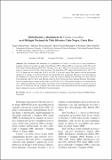| dc.contributor.author | Cabrera Peña, Jorge | |
| dc.contributor.author | Protti Quesada, Maurizio | |
| dc.contributor.author | Urriola Hernández, Mario | |
| dc.contributor.author | Cubero Murillo, Rolando | |
| dc.date.accessioned | 2020-06-12T02:24:09Z | |
| dc.date.available | 2020-06-12T02:24:09Z | |
| dc.date.issued | 2003 | |
| dc.identifier.issn | 00347744 | |
| dc.identifier.uri | http://hdl.handle.net/11056/17562 | |
| dc.description.abstract | The distribution and abundance of a population of Caiman crocodilus fuscus were estimated by monthly counting of eyeshines at night, from February 1999 to March 2000 in six transects of Río Frío in the
Caño Negro National Refuge (RNVSCN), Northern Costa Rica. March was the month with the greatest abundance of caimans observed. The visible fraction of the population (PV2 index) fluctuated between 42.59 % to 54.71 % during the wet season and 35.49 % to 53.93 % in the dry season. The transects of river with greater abundance of caimans were Terrón-Sabogal and Sabogal-Playuela. Significant differences were determined in the abundance of caimans between transects, except the transects Entrada San Sebastían-Las Cubas and Las Cubas-Entrada Caño Los Patos and Entrada Caño Los Patos-Terrón and Boca Sabogal-Playuela. The population of estimated brown caiman in this study was 2283.48 ± 313.5. The statistical analysis by seasons did not show significant differences in the number of caimans observed. Estimated mean number of caimans per km of river was 74.36 /km for 30.7 km of habitat. The results of this study indicated that the fluctuation in population density during the seasons is attributable to local movements. | es_ES |
| dc.description.abstract | La distribución y abundancia de una población de Caiman crocodilus fuscus se estimó contando mensualmente el brillo de los ojos por la noche, desde febrero de 1999 hasta marzo de 2000, en seis transectos de Río Frío en el Refugio Nacional Caño Negro (RNVSCN), norte de Costa Rica. Marzo fue el mes con la mayor abundancia de caimanes observados. La fracción visible de la población (índice PV2) fluctuó entre 42.59% a 54.71% durante la estación húmeda y 35.49% a 53.93% en la estación seca. Los transectos de río con mayor abundancia de caimanes fueron Terrón-Sabogal y Sabogal-Playuela. Se determinaron diferencias significativas en la abundancia de caimanes entre transectos, excepto los transectos Entrada San Sebastían-Las Cubas y Las Cubas-Entrada Caño Los Patos y Entrada Caño Los Patos-Terrón y Boca Sabogal-Playuela. La población del caimán marrón estimado en este estudio fue de 2283.48 ± 313.5. El análisis estadístico por estaciones no mostró diferencias significativas en el número de caimanes observados. El número medio estimado de caimanes por km de río fue de 74.36 / km por 30.7 km de hábitat. Los resultados de este estudio indicaron que la fluctuación en la densidad de población durante las estaciones es atribuible a los movimientos locales. | es_ES |
| dc.description.sponsorship | Universidad Nacional, Costa Rica | es_ES |
| dc.language.iso | spa | es_ES |
| dc.publisher | Revista de Biología Tropical vol.51 no.2 571-578 2003 | es_ES |
| dc.rights | Acceso abierto | es_ES |
| dc.rights.uri | http://creativecommons.org/licenses/by/4.0/ | * |
| dc.source | • Cabrera Peña, Jorge, Protti Quesada, Maurizio, Urriola Hernández, Mario, Cubero Murillo, Rolando (2014). Distribución y abundancia de Caiman crocodilus en el Refugio Nacional de Vida Silvestre Caño Negro, Costa Rica. Universidad de Costa Rica. www.ots.ac.cr | es_ES |
| dc.subject | CAIMAN | es_ES |
| dc.subject | CAIMAN CROCODILUS | es_ES |
| dc.subject | POPULATION DENSITY | es_ES |
| dc.subject | ABUNDANCE | es_ES |
| dc.subject | CAÑO NEGRO NATIONAL WILDLIFE REGUGE (COSTA RICA) | es_ES |
| dc.title | Distribución y abundancia de Caiman crocodilus en el Refugio Nacional de Vida Silvestre Caño Negro, Costa Rica | es_ES |
| dc.type | http://purl.org/coar/resource_type/c_6501 | es_ES |
| dc.description.procedence | Escuela de Ciencias Biológicas | es_ES |


